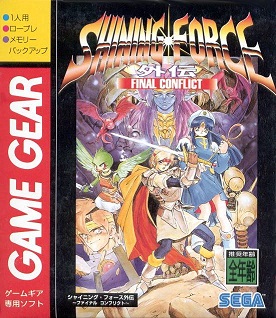
Camelot Software Planning has a history beginning with the Shining games on the Sega Genesis, the first the dungeon-crawling Shining in the Darkness, although its sequels would take a different route, with Shining Force being an tactical roleplaying title. Before the release of the second main Shining Force game, Sega released two side stories for the portable GameGear under the Shining Force Gaiden banner, the second seeing English release, although non-Japanese gamers would get the first as part of the collection Shining Force CD. During the transition between console generations in 1995, Sega released the last of the franchise’s gaiden games, Shining Force Gaiden: Final Conflict, which aimed to bridge the gap between the first and second of the series’ primary entries.
Rather than continuing the story of the Cypress Shining Force, Final Conflict instead opens with the leader of the original group, Max, chasing Mishaela, servant of the devil king Darksol, with Max’s trail ultimately going cold, his robot servant Adam receiving injuries and becoming unable to fight, although he survives to guide the newest Shining Force and its enigmatic leader Ian in search of the missing hero. The story was actually not bad for its time, being laden with Continuity Porn and having some good twists, although most Shining Force members receive scant development.
Final Conflict, more or less, features the same tactical gameplay as other entries in the Shining Force franchise, turn-based and grid-based, the player’s characters and the enemy taking turns depending upon the agility stat. Ian’s death results in a return to the last resting point and a loss of half the player’s money, although if things aren’t going in the player’s favor, Ian (and towards the end, another character) can cast the Egress spell to return to said rest area to perform tasks such as reviving deceased characters, cleansing them of status ailments such as poison, and promoting characters once they’ve advanced ten levels, granting them access to more powerful weapons.
The playable cast is somewhat smaller than in other series entries, although this isn’t necessarily a bad thing as it somewhat reduces the cost of maintaining the Shining Force as a whole, although characters of specific classes such as archer aren’t in great supply, with a gravitation towards swordsmen, many of which can fly and have great moving range regardless of the various battlefields’ terrains. The game lacks modern conveniences such as a turn-order meter, the player has to center area-affecting sorcery on enemies to execute it, and leveling weaker characters can be mildly tedious, although there are some quirks such as being able to adjust to lower levels of magic spells when they advance through leveling, and the gameplay is definitely a boon.
Another area where Final Conflict lacks modern conveniences, albeit to a larger degree, is control, although it does have some highlights such as the virtual impossibility of losing oneself, given the game’s rigid linearity, not to mention the ability to quit battles during the player’s characters’ turns and resume where they left off. Even so, the game bombards players with dialogue and confirmations when performing functions such as shopping for new equipment and items, consumables and magic lack in-game descriptions, and the player can’t see how weapons will increase or decrease power before equipping it. Regardless, interaction is by no means a total writeoff.
Perhaps the strongest aspect of Final Conflict is its soundtrack by Motoaki Takenouchi, much of which comes from the series’ second main entry, although the different sound quality of the GameGear prevents the tracks from being total rehashes.
The visuals also looked good for an 8-bit portable game, with important characters having distinct portraits and largely matching their sprites with occasional exceptions, not to mention detailed scenery, action, and models during the franchise’s trademark attack sequences, although things aren’t perfect, given occasional reskinned foes.
One can potential beat the game within a day, although there isn’t much reason to come back from more, with the player needing to consult the internet to unlock advanced difficulty, for instance.
Regardless of flaws within the gameplay and interface, not to mention the lack of lasting appeal, Shining Force Gaiden: Final Conflict was a great GameGear title that North American players unfortunately missed out on, given the general solid strategy system of the Force subseries, its straightforward nature, its enjoyable and franchise-adjoining narrative, its excellent soundtrack, and nice, colorful 8-bit visuals. It definitely ranks as one of Camelot’s strongest forays into the roleplaying game genre (and is far from the low of titles by the same developer such as Beyond the Beyond), and interested Anglophone players will appreciate the existence of an English fan translation.
The Good:
+Simple but solid Shining Force gameplay.
+Impossible to get lost.
+Good story that connects the first and second main games.
+Great music.
+Nice 8-bit graphics.
The Bad:
-No town access before some battles.
-Clunky, sometimes uninformative interface.
-Little reason to pay multiple times.
The Bottom Line:
A good gaiden game.
Score Breakdown:
Platform: GameGear
Game Mechanics: 7/10
Controls: 6/10
Story: 8/10
Music/Sound: 9/10
Graphics: 8/10
Lasting Appeal: 5/10
Difficulty: Moderate
Playing Time: 12-24 Hours
Overall: 7.5/10
No comments:
Post a Comment